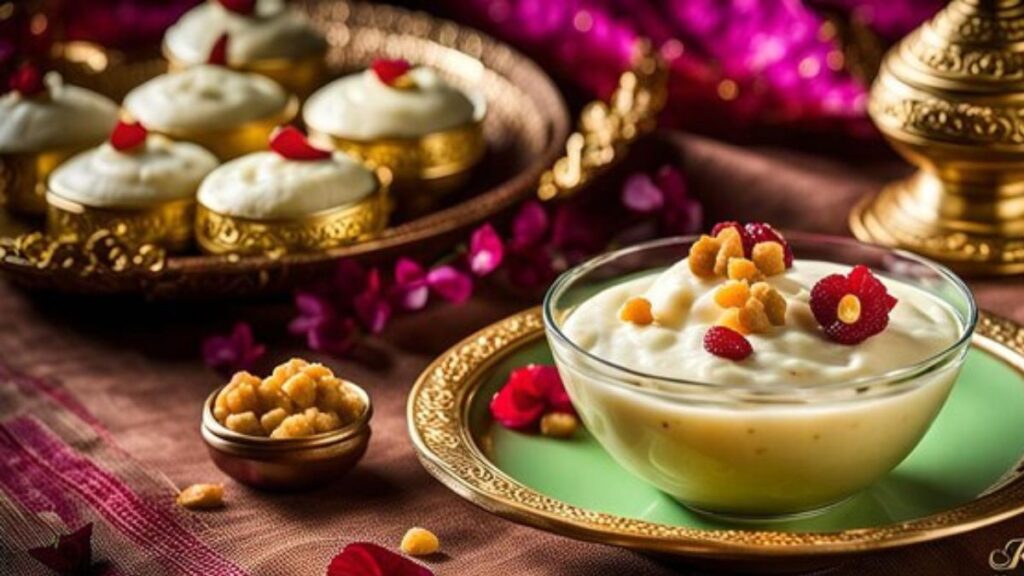Cultural significance in mouhalabieh a creamy and delicate milk pudding, is more than just a dessert; it is a culinary tradition that has transcended borders and generations. This beloved dish, often flavored with rose water or orange blossom water and topped with pistachios or almonds, holds a special place in the hearts of many cultures across the Middle East, Mediterranean, and beyond. In this article, we will explore the cultural significance of mouhalabieh, its historical roots, and its enduring appeal in modern cuisine.
Historical Roots of Mouhalabieh
The origins of mouhalabieh can be traced back to the medieval Arab world, where it was known as “muhallabia.” The dessert is believed to have been named after an Arab general, Al-Muhallab ibn Abi Sufra, who was fond of this creamy treat. Over time, the recipe spread across the Middle East, Mediterranean, and even parts of Europe, adapting to local tastes and ingredients.
In its simplest form, mouhalabieh is made from milk, sugar, and rice flour or cornstarch, which gives it its signature smooth texture. The addition of floral waters like rose or orange blossom adds a fragrant touch, while nuts provide a contrasting crunch. This combination of simplicity and elegance has made mouhalabieh a staple in many households and a symbol of hospitality.
Mouhalabieh in Middle Eastern Culture
In Middle Eastern culture, mouhalabieh is more than just a dessert; it is a symbol of warmth, generosity, and tradition. It is often served during special occasions such as weddings, religious holidays, and family gatherings. The act of preparing and sharing mouhalabieh is a way to express love and care for guests, making it an integral part of social customs.
For example, during Ramadan, mouhalabieh is a popular choice for iftar, the meal that breaks the daily fast. Its light and refreshing qualities make it an ideal dessert after a day of fasting. Similarly, in Lebanon and Syria, it is commonly served during Easter and Christmas celebrations, often accompanied by other traditional sweets like baklava and maamoul.
Mouhalabieh in Mediterranean Cuisine
As mouhalabieh traveled westward, it became a part of Mediterranean cuisine, particularly in Greece and Turkey. In Greece, a similar dessert known as “mahalepi” is made with the same basic ingredients but is often served chilled and topped with a sweet syrup. In Turkey, “muhallebi” is a popular dessert that is sometimes flavored with cinnamon or served with a layer of fruit compote.
The adaptability of mouhalabieh has allowed it to seamlessly integrate into different culinary traditions while retaining its essence. This versatility is a testament to its universal appeal and the shared cultural heritage of the regions it has touched.
Mouhalabieh in Modern Cuisine
In recent years, mouhalabieh has experienced a resurgence in popularity, thanks to the growing interest in traditional and regional cuisines. Chefs and home cooks alike are rediscovering this classic dessert and experimenting with new flavors and presentations. For instance, some modern variations include adding cardamom, saffron, or even chocolate to the pudding, giving it a contemporary twist.
Moreover, mouhalabieh has found its way into the menus of high-end restaurants, where it is often served as a sophisticated dessert with artistic plating. Its simplicity and elegance make it a favorite among food enthusiasts who appreciate the balance of flavors and textures.
The Symbolism of Mouhalabieh
Beyond its culinary appeal, mouhalabieh carries deep cultural symbolism. Its creamy texture and delicate flavors are often associated with purity and comfort, making it a popular choice for celebrations and rituals. In some cultures, it is also believed to have healing properties, particularly when made with natural ingredients like rose water, which is known for its calming effects.
The act of sharing mouhalabieh is also symbolic of unity and togetherness. Whether it is served at a family dinner or a festive gathering, it brings people together and creates a sense of community. This shared experience is a reminder of the importance of preserving cultural traditions in an increasingly globalized world.
Conclusion
Cultural significance in mouhalabieh is more than just a dessert; it is a cultural treasure that has stood the test of time. Its rich history, adaptability, and symbolic significance make it a beloved dish in many parts of the world. Moreover, as we continue to explore and celebrate traditional cuisines, mouhalabieh not only serves as a reminder of the power of food to connect us to our roots but also strengthens our bonds with each other.
Whether you enjoy it as a comforting treat at home or as an elegant dessert at a fine dining restaurant. Mouhalabieh is sure to leave a lasting impression. Its timeless appeal is a testament to the enduring beauty of cultural traditions. And the universal language of food cultural significance in mouhalabieh.
FAQs
1. What is mouhalabieh?
Mouhalabieh is a creamy milk pudding made from milk, sugar, and rice flour or cornstarch. It is often flavored with rose water or orange blossom water and topped with nuts like pistachios or almonds.
2. Where did mouhalabieh originate?
>>>>>>>>>>>>>>>>>>>>>>>>Mouhalabieh has its roots in the medieval Arab world and is believed to have been named after an Arab general, Al-Muhallab ibn Abi Sufra.
3. How is mouhalabieh served?
>>>>>>>>>>>>>>>>>>>>>Mouhalabieh is typically served chilled and can be enjoyed on its own or with toppings like nuts, fruit compote, or sweet syrup.
4. Is mouhalabieh served during special occasions?
>>>>>>>>>>>>>>>>>>>>>Yes, mouhalabieh is often served during special occasions such as weddings, religious holidays, and family gatherings in Middle Eastern and Mediterranean cultures.
5. Can mouhalabieh be made with different flavors?
Absolutely! While traditional mouhalabieh is flavored with rose water or orange blossom water. Modern variations may include cardamom, saffron, or even chocolate.
6. Is mouhalabieh difficult to make?
No, mouhalabieh is relatively simple to make and requires only a few basic ingredients. The key is to achieve a smooth and creamy texture.
7. Is mouhalabieh gluten-free?
Yes, if made with rice flour or cornstarch, mouhalabieh is naturally gluten-free.
8. Can mouhalabieh be made vegan?
>>>>>>>>>>>>>>>>>>>>>Yes, mouhalabieh can be made vegan by using plant-based milk like almond or coconut milk and substituting sugar with a vegan-friendly sweetener.
9. How long does mouhalabieh last in the fridge?
Mouhalabieh can be stored in the refrigerator for up to 3-4 days. Make sure to cover it tightly to prevent it from absorbing other odors.
10. What makes mouhalabieh culturally significant?
Mouhalabieh is culturally significant because it represents hospitality, tradition, and unity. It is often shared during celebrations. And gatherings, symbolizing warmth and togetherness.x






